 |
 |
 |
 |
|
 |
|
 |
 |
|
 |
 |
 |
|
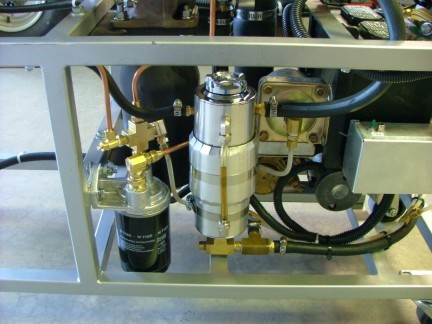 |
|
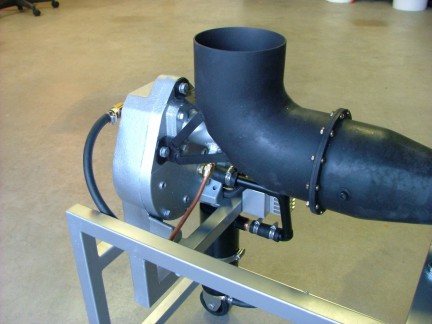 |
|
|
For my generator system, I installed a surplus permanent magnet DC motor next to the gearbox. I set up a pulley system to drive the motor at about 8500 RPM to generate 13 volts at 10 amps. I needed to make a 4.25:1 drive system for this so I machined an aluminum pulley to drive a smaller steel pulley on the DC motor. (Calculated at proposed average shaft speed of 2000 RPM) I used a common vacuum cleaner belt to connect the two pulleys as I did for the oil pump, works great! I installed a 25 amp diode to keep the motor from drawing any current from the battery but allowing it to charge the system. The system isnít perfected but itís working.
|
|
|
|
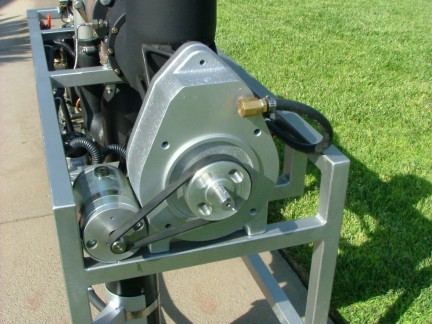 |
|
|
|
The finished turbine looks pretty good! There is a lot of room under the power turbine for additional equipment. I may convert the engine to run on diesel later on, so a 3 gallon tank may go there. Although I will have to build a heat shield under the turbine if I do install a tank. As for weight goes, the completed engine weighs 155 pounds. A little heavy in comparison to a commercial engine but thatís OK for a first attempt. I will try to hack off some weight on future models.
|
|
|
|
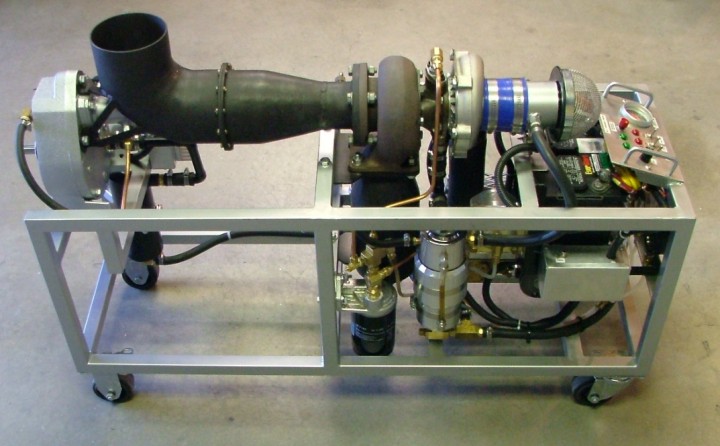 |
|
|
|
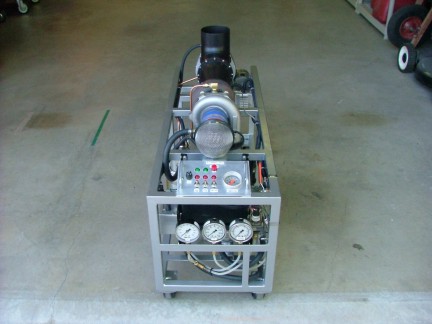 |
|
|
|
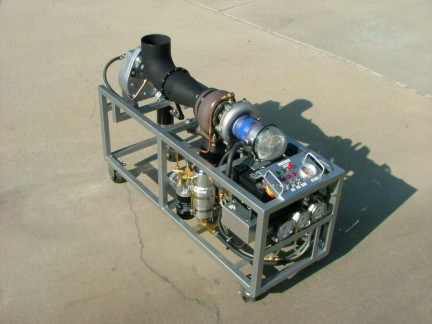 |
|
|
|
 |
|
|
|
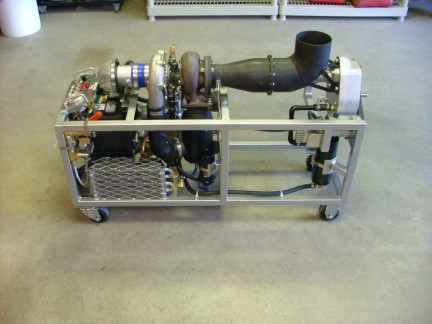 |
|
|
|
 |
|
|
|
I had estimated the power turbines operating speed at about 15,000 RPM at top end. My hopes were to keep the turbine from overspeeding by installing a propeller on the output shaft. I figured with some resistance the turbine wheel would stay behind the flow of gas and not overspeed. I needed a propeller that would give the required resistance at around 2000 RPM. There were really none to be found as most ultralight props are fairly large (46Ē+) and would require a special hub.
I needed something cheap and fast so I made one out of the cleanest 2 X 4 I could find at Home Depot. I basically whittled this thing out with my band saw and then fine tuned and balanced it with my belt sander. The 34Ē prop should do the trick as long as the tips donít go supersonic! Ha Ha.. I donít think Home Depot would guarantee their framing stud for aircraft use :o)
I made a four bolt hub out of an old aluminum Lovejoy coupler and some 1/4-20 bolts. The propeller looks cool and there is nothing stopping me from starting her up. I set up the pitch to push the engine rather than pull so the operator would not have wear aviator goggles.
|
|
|
|
 |
|
|
|
The prop looks like something off of the Wright Flier doesnít it?
|
|
|
|
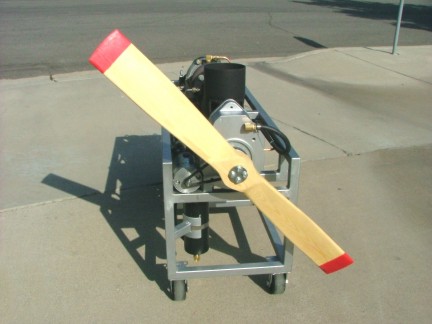 |
|
|
|
I set the GR-5 outside my garage on some cardboard in case of a oil spill. I was fairly nervous as I plugged in the propane. I started up the oil pump and let it run for a minute to stabilize. I turned on the tachometer sensor so I could see if the rotor was spinning and started up the blower to spool up the turbine. With a FFFUPPP and a growl the turbine started to ramp up. Even though I had my hearing protection on, I could hear a change in itís sound from before.
The turbine sounded more like a commercial one with a low rumble that dissipated with speed. The power turbine was spinning slowly and as I throttled it up I noticed the output shaft was slowing down so I shut down the engine. I quickly grabbed the stopped propeller and felt for rubbing. I could feel that the blast seal collar was rubbing the heat shield. Within seconds the friction was gone so I fired it up again to see if this was the case. As soon as the turbine got up to speed the power turbine slowed to a stop.
I had to disassemble the turbine and readjust the blast seal. After about 45 minutes, I was ready again. This time I set the seal to about a 0.015Ē gap and re-torqued everything. The GR-5 started up without any problems and I ran her at 1 PSI for a couple of minutes. The propeller started to spin slowly and I could hear the whine of the power turbine. It was very cool hearing this thing start to sing. All I needed was the shiwish of a helicopter rotor overhead - awesome! Chills were going down my spine as the engine whined away.
|
|
|
Once the engine reached operating temperature I set the oil metering valve for the turbine bearing. The oil levels were looking good and stayed in range for the duration of the test.
|
|
|
|
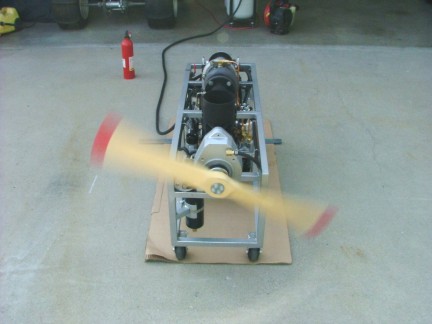 |
|
|
|
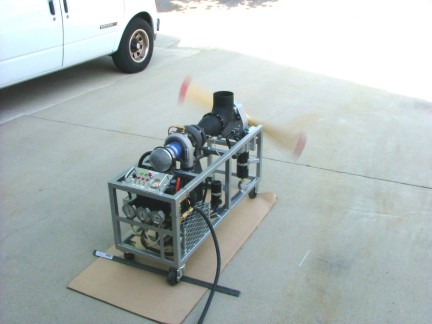 |
|
|
|
 |
|
|
|
The power turbine spun at about 800 RPM and showed no signs of slowing or vibration. I poured on the fuel and watched the propeller start to blow. The sound was so cool as the harmony of the two turbines blended with the propeller. I used a model airplane tachometer to test the RPM and measured 825 RPM from the prop at 6 PSI boost. This would indicate that the power turbine was turning at 4125 RPM. I needed to know If I could make the estimated RPM of 15000 so I cracked the throttle up to 15 PSI combustor pressure.
|
|
|
The propeller was turning at around 2150 RPM which puts the turbine at 10,750 RPM. The exhaust temperature was 850 deg. Fahr. which is much cooler than the GR-1 ran. I ran the engine for 15 minutes at 6 PSI and it showed no signs of slowing or smoking. Even though the propeller is very un- aerodynamic, the GR-5 still had 36 pounds of thrust! I am incredibly curious on how much power the GR-5 is producing and I will have to find a way to dyno the engine.
See the GR-5 engine demo video here!!!
|
|
|
|
 |
|
|
|
Well gentlemen, the GR-5 actually works! I cant believe that this pile of scrap pipe is a working turboshaft engine. And to think I only spent about $900 on the engine. (Not including the $800 tooling investment) Seems you cant even touch a used commercial gas turbine for under $2500! I couldn't even imagine how expensive repair parts are for a commercial gas turbine figuring that they cost about $20,000+ new.
|
|
|
I am very pleased with the engine and I am looking forward to putting it into service. I am not sure what to put it into yet as I do not have the horsepower rating for the engine yet. When I test the HP, I can find the most suitable job for the engine. I was kind of thinking a riding lawnmower with an afterburner - that would make Tim Taylor proud. Maybe the GR-5 would fit into a large scale Union Pacific Gas Turbine Locomotive model, that would be really cool! Or maybe a margarita turbo-blender................ OK maybe not :o)
I will do the research and post my findings on the power output and RPM soon. With any luck, I will be able to report good numbers.
Until next time,
Don Giandomenico, Novice Gas Turbine Mechanic :0)
|
|
|
|
 |
|
 |
|
 |
|